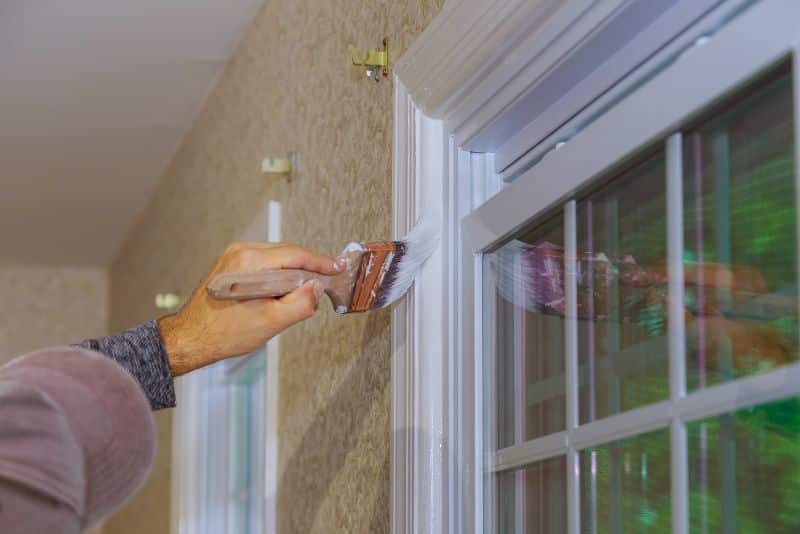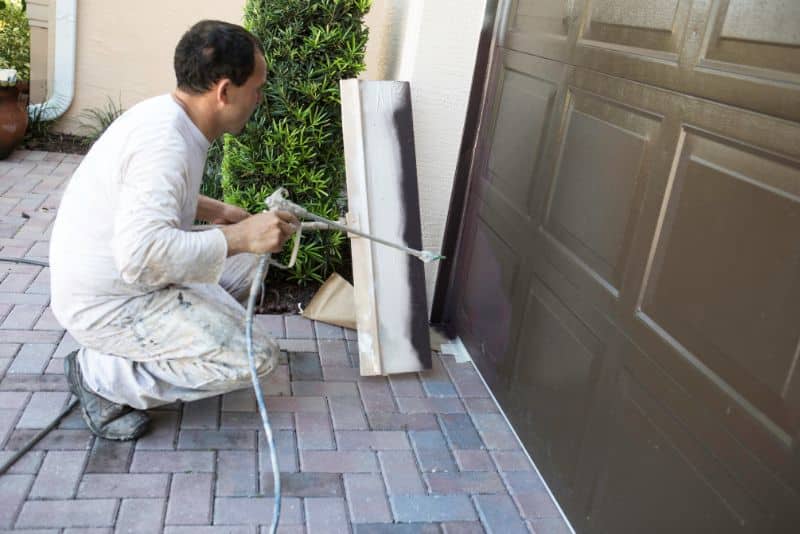What is uPVC?
uPVC or unplasticised polyvinyl chloride is one of the most popular polymers used in house construction. Most houses will have at least one of the following:
- uPVC windows
- uPVC doors
- uPVC garage doors
- uPVC conservatory
It is an inexpensive and versatile material that will withstand most weather conditions and temperatures, and offers homeowners a certain amount of freedom when it comes to the style of their home.

Why paint uPVC windows?
Many people chose to paint uPVC window frames, front doors and garages in order to improve the appearance of their home. By doing so, they can increase the home’s kerb appeal and subsequently increase the value of their property. It is also a great way to show personality in a property. Painting the uPVC windows and doors of a property a fun, exciting colour separates a property from the others on its street.
Painting uPVC is also cheaper than getting new uPVC (by about 75%!) and is substantially faster and easier, too. It can be done by a group of professionals or even by the homeowners themselves, making it an accessible way to improve the way a building looks whilst also providing a layer of UV protection for the plastic.
What paint will work on uPVC?
Due to the nature of uPVC, it requires a certain type of paint. Using another type of paint will lead to a bad finish and the new colour may well peel off of the paint within weeks. In order to achieve a durable finish, plastic paints should be used. Plastic paint is a type of solvent based paint that is specifically formulated to last on plastic. uPVC paints will specify whether they are to be used indoors or outdoors, and painters should pay attention to these labels.
Typically, uPVC paint is best used as a spray paint. This reduces the risk of brush marks disrupting the quality of the paint job, and allows an even coating to be added to the uPVC windows. If you are choosing to paint uPVC rather than hire someone, investing in a spraying kit may well be worthwhile.
For some uPVC paints, a plastic primer will be needed before you paint uPVC. You simply paint this primer onto the uPVC windows before you begin to paint, and it will help to improve the depth of colour as well as ensure there is proper adherence. It is particularly useful when painting over dark colours; like if you were painting brown uPVC windows to a light grey.
So long as the right uPVC paint is used to paint uPVC windows, the finish should be relatively durable. When the surface is prepared correctly, the paint should last up to around 10 years.
What are the best conditions to use uPVC paint in?
There are a few things that need to be just right before you paint uPVC. uPVC paint is quite temperamental, and painting uPVC without taking the necessary steps will simply result in a poor job.
Weather conditions
The ideal weather to paint uPVC windows and doors in is hard to guarantee, but if you are going to wait for the perfect day to get your spray paint out, you should keep an eye out for an air temperature range of between 10 degrees Celsius and 30 degrees Celsius. The ideal day will not put your house in direct sunlight, and will, if anything, be an overcast day. You should avoid a day with cold air, or particularly cold weather, and should especially avoid the rain. A dry, overcast day within the above temperature range will allow your uPVC paint to dry perfectly while you paint uPVC windows.
So, in answer to the question: can uPVC be painted in cold weather, the answer is no. Many plastic paints and solvent-based paint colours will struggle to bind to the uPVC in cold weather, and the cold weather slows down the drying process substantially. Likewise, though uPVC windows in direct sunlight the paint will dry too quickly and this can lead to peeling and cracking.

The uPVC surfaces
As well as the weather, the state of the uPVC surfaces that you are painting is also absolutely key. Your uPVC windows should be properly prepared prior to getting your plastic paints out, as without doing so you will likely find that your solvent-based paint dries bumpy, patchy or peels off not long after finishing the job.
The first step in preparing the uPVC windows and doors is to make sure you do a thorough clean of the surface and window tracks with warm soapy water and a cloth. Cleaning the surface correctly will help to prevent anything from getting trapped under the paint.
You should then fill any gaps in the uPVC windows with caulk or filler, and sand the entire surface down. This will also help to prevent brush marks by providing a flatter surface for your solvent-based paint.
The uPVC windows should also be at least a few weeks old, as the bonding agent within many uPVC paints will struggle to attach to new uPVC, even if used as a spray paint. uPVC windows should be left for around a month before painting to allow the paint to properly adhere.
How long does uPVC paint take to dry?
Solvent-based paint, regardless of whether it is painted on by hand or used as a spray paint will feel dry to touch on your uPVC windows and doors within 10 to 15 minutes. Each coat (including plastic primer if using it) should be left to dry for between 30 minutes and an hour to ensure that it is not going to smudge before continuing on with the solvent-based paint.
The spray paint will not be fully dry, however, until around 7 days after painting. This may be longer if the weather has been poor, as cold weather slows the drying process. Likewise, it may be longer if you have not painted the surface correctly or prepared the surface correctly.
